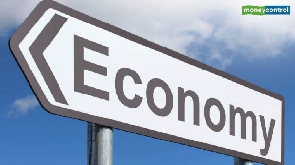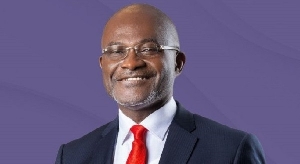- Home - News
- TWI News | TV
- Polls
- Year In Review
- News Archive
- Crime & Punishment
- Politics
- Regional
- Editorial
- Health
- Ghanaians Abroad
- Tabloid
- Africa
- Religion
- Election 2020
- Coronavirus
- News Videos | TV
- Photo Archives
- News Headlines
- Press Release
General News of Tuesday, 25 July 2006
Source: Palaver
Ghana Subsidises VALCO to ¢1.5 Trillion
While Ghanaians go to bed on empty stomachs!!
Palaver -- Ghana’s sovereign Parliament last week approved an amount of ¢350 billion as subsidy to the beleaguered Volta Aluminum Company Limited (VALCO) in approving the Supplementary Budget presented to the House by Finance Minister Kwadwo Baah Wiredu.How this ridiculous situation occurred at a time when the Government is increasing electricity prices and is also subsidising the price of the same commodity for VALCO, a company in which the multinational corporation ALCOA has 10% ownership, is the story of one of the most irresponsible policy decisions and incompetent negotiations that any Third World country could take or engage in.
When for the construction of the Akosombo Dam, Kwame Nkrumah negotiated the very low power rate of US$2.265 mills per kilowatt hour (kwhr) with VALCO, it was understandable because the supply of electricity at the time was more than the demand. In fact, the whole country was going so consume not more than 15% of the total electricity that the Akosombo Dam Project was going to produce, so we needed an investor like VALCO to create the market in order to make the Project economical, profitable and attractive to investors.
When the NPP Government came to power, the supply-demand situation was changing and in recognition of this, VALCO itself had agreed with the PNDC/NDC Governments through a series of re-negotiations to increase the power rate.
The last NDC re-negotiated power rate in December 2000 would have earned VRA, and therefore Ghana, about US$30 million a year. The NPP Government cancelled this Agreement, VALCO closed down, and the principal shareholder, Kaiser Aluminium, sold out its 90% shares to the Ghana Government. The minority shareholder, Reynolds Metals, also sold out its 10% interest to ALCOA, which retained that interest, making the present VALCO shareholding Ghana Government: 90% and ALCOA: 10%.
The Ghana Government then had to renegotiate the resumption of operations by VALCO. At that time the supply-demand situation had changed completely. The whole of Ghana had been hooked on to the national grid and Akosombo was also supplying power to La Cote d’Ivoire, Togo and Benin. There was therefore more demand for electricity than VRA could produce, forcing the Authority to put more reliance on the more expensive thermal generation.
It was at this time that the NPP Government took two disastrous policy decisions:
(i) At a time when the total production of electricity could not meet the demand – what with the whole country now connected to the national electricity grid and Cote d’lvoire, Togo and Benin all taking supplies from Ghana – the Ghana Government decided that VALCO should come back on stream;
(ii) Since VALCO’s operations would not be profitable if it paid the same price for electricity as all other consumers, the NPP Government negotiators incompetently agreed that VALCO should pay US$2.7 mills/kwhr. A mill is 1/100 of a cent, so translated into cedi terms, it means VALCO pays ¢595.0 for every kilowatt-hour of electricity supplied to it by VRA whilst it cost VRA ¢256.7 to produce that quantity of electricity.
This is where the VRA’s losses have come from, and hence the need for a state subsidy.
In our April 28 – May 1, 2006, Vol 12 No. 57 edition, we carried a Front Page Comment titled, “VRA is Broke”.
In that Comment, we provided evidence to the effect that VRA, once the flagship of Ghanaian corporate business, is broke and may be declared bankrupt. We opined in that Comment that in 2005, VRA posted an operating loss in income of ¢727 billion compared to an operating profit of ¢437 billion in 2004.
We attributed this poor performance of VRA to the cost of production of power being much higher than the selling price of power to VRA’s customers. We provided evidence to show that for every kilowatt-hour (kwhr) of energy sold to Valco, VRA subsidised Valco to the tune of ¢455/kwhr or US4.8 cents/kwhrs.
We stated that with Valco back on stream, the mix of VRA power had shifted to thermal power being utilised as base load whilst the cheaper hydropower was now a supplementary power load. We stated that there was no need for Valco to be brought back on stream at a time when crude oil prices were constantly spiralling upwards.
We at ‘Ghana Palaver’ thought the Government and VRA had paid no heed to the issues we raised. But apparently, we were mistaken for on 2nd June 2006, the Chief Executive of VRA, Mr. Joshua K. Ofedie, wrote a letter to the Minister of Finance and Economic Planning titled, “Impact of Energy Supply to Valco on Financial Situation 2006”.
In this letter, the VRA stated that it had “further reviewed our coverage cost of service in the light of prevailing cost of fuel and also the supply mix required to meet Valco demand”. Based on crude oil price at end of May 2006 of about US$60/bbl, VRA determined that its average cost of power production was ¢595/kwhr or US6.27 cents/kwhr.
Meanwhile, VRA was selling power to Valco at ¢256.5/kwhr or US2.7 cents/kwhr. Thus for every kwhr of power sold to Valco, VRA incurred a loss of ¢339/kwhr or US3.57 cents/kwhr.
In 2005, VRA supplied Valco 25 Gwhr of power and lost ¢87.88 billion or US$9.25 million in that transaction.
In 2006, VRA is required to supply Valco 1,240 Gwhr of power. The VRA is expected to lose ¢420.6 billion or US$44.27 million in this transaction also.
For the years 2005 and 2006 therefore, VRA is losing ¢508.45 billion or US$53.52 million in its dealings with Valco.
According to the VRA Chief Executive, the “additional cost of supply to VALCO would be spread evenly over all consumers” and that the under recovery of additional burden imposed by VALCO on the Bulk supply Tariff (BST) is ¢787.08 billion or US$82.85 million for ECG and ¢119.23 billion or US$12.55 million for 2006 alone. As a result of VRA’s under recovery of tariffs from VALCO, VRA in 2006 alone will lose ¢1.41 trillion or US$148.92 million. For 2005 and 2006, VRA loses as a result of power sales to Valco will amount to ¢1.50 Trillion or US$158.17 million.
Following this letter of gloom and doom from the VRA, the NPP Government in its Supplementary Budget Estimates presented by the Minister of Finance and Economic Planning on 13th July 2006 states at page 110, paragraph 443 that: “subject to reconciliation of data between VRA and Government, an amount of between ¢274.4 billion and ¢320 billion is earmarked to be allocated to the Ministry of Finance and Economic Planning to be used as compensation to VRA for the difference in costs of generation and sale of power to VALCO”.
In simple English, what the Finance Minister is saying is that VRA has subsidised VALCO to the tune of ¢1.50 Trillion, and that ¢320 billion of the additional resources of ¢4.28 trillion expected from the Multilateral Debt Relief Initiative would be used to subsidise VALCO’s operations.
This subsidy of ¢320 billion to VALCO, amounting to wilfully causing financial loss to the State, could be used to build schools, hospitals, and provide good drinking water to many of our villages and citizens.
A number of issues have still to be resolved:
(i) The VRA’s subsidy to VALCO is ¢1.5 Trillion and Government is absorbing only ¢320 billion. When will the outstanding balance of ¢1.18 Trillion be paid to VRA to save the Authority from collapse?
(ii) If Government does not obtain additional resources in future, how will VALCO’s indebtedness to VRA be liquidated?
(iii) Is the Ghanaian taxpayer going to be saddled with additional taxes to cater for VRA’s subsidy to VALCO permanently?
(iv) How can the disparity between the cost of power to VALCO and revenue from power sales be bridged since VALCO would not like to pay more than the ¢285/kwhrs or US3.00 cents/kwhr for power it has negotiated with the NPP Government whilst the production cost of power is over ¢700/kwhr?
(v) If this disparity cannot be bridged, does it mean that tariffs to domestic customers are going to be raised to bridge the gap?
(vi) In subsequent years, as VALCO’s power requirements increase, VRA’s subsidy to VALCO will also increase. How do we as a nation ensure that VRA does not collapse?
(vii) VRA cannot continue to subsidise VALCO, another corporate entity, in such large amounts in perpetuity and hope to survive.
Finally can some one tell Ghanaians the wisdom in reopening VALCO at this time? And does President Kufuor and his Government realise that whoever negotiated this deal with Valco has wilfully caused financial loss to the State amounting to Trillions upon Trillions of cedis?
We reproduce below the VRA Chief Executive’s letter to the Minister of Finance and Economic Planning, which speaks for itself.










